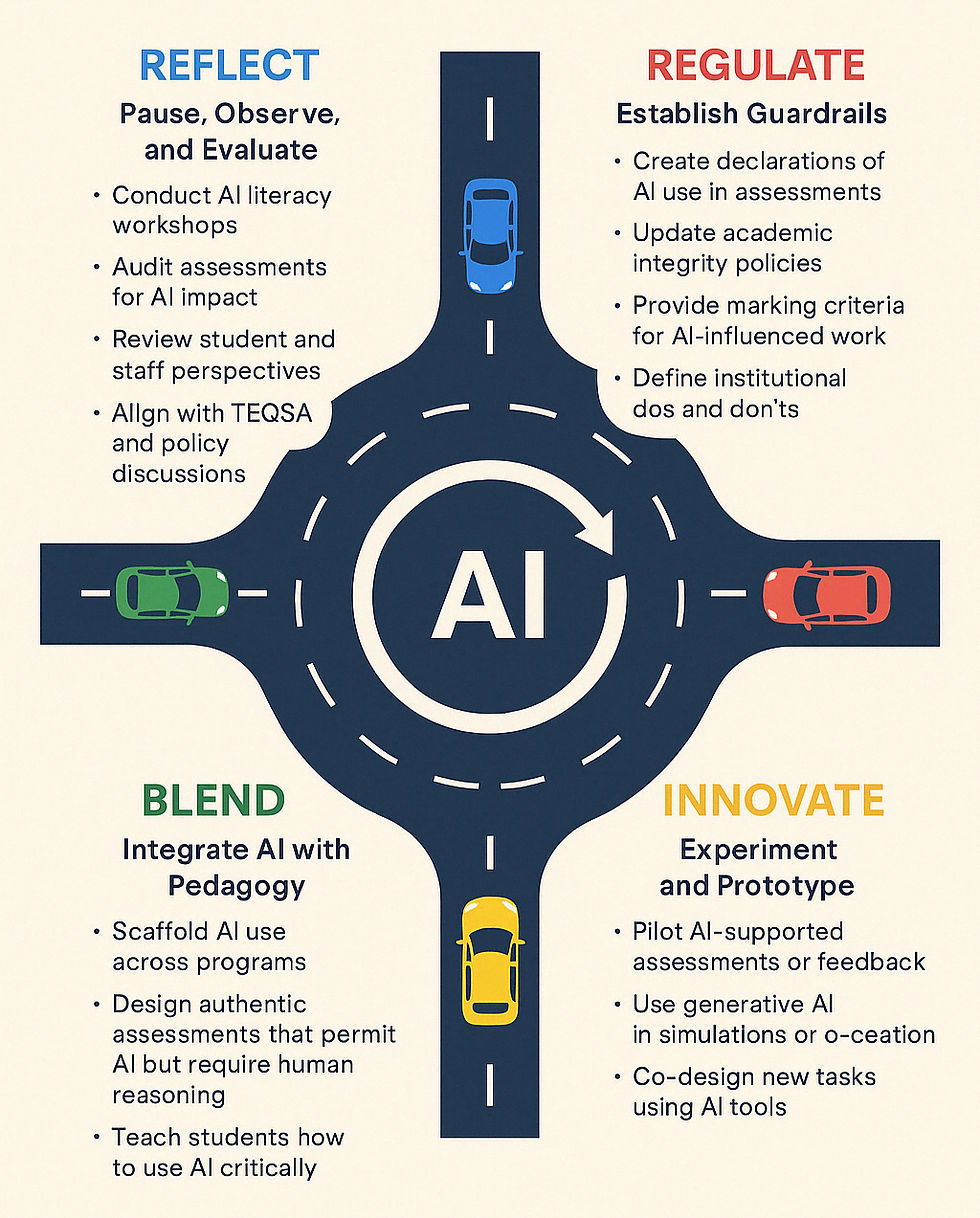Navigating AI in Education: Roundabout Conceptual Approach - Why it Might Be the Better Road Ahead
- Morty Lab
- Apr 21
- 3 min read
As artificial intelligence (AI) continues to disrupt and enhance the landscape of higher education, institutions and educators are grappling with how best to respond — ethically, strategically, and practically. Two widely circulated models, UNSW’s “Two to Six Lanes” and The University of Sydney’s “Two-Lane Program-Level Assessment”, have provided helpful ways to frame the conversation around AI in assessment.
But what if we need a more flexible model? One that embraces choice, iteration, and diverse speeds of adoption?
Introducing the Roundabout Conceptual Approach — a dynamic, multi-exit approach to navigating AI in teaching, learning, and assessment.
From Lanes to Roundabouts: Why It Matters

While the "lane" metaphors provide structure, they can also feel limiting. They imply a fixed direction or progression — when in reality, integrating AI into education is anything but linear. Disciplines differ, policies shift, technologies evolve, and ethical considerations deepen.
A roundabout, on the other hand, encourages navigation, entry and exit, and even looping back to reflect and adapt.
The Roundabout Concept Approach Explained
At the heart of the roundabout is AI — the tool, the disruptor, the opportunity.
Surrounding it are four primary exits or lanes educators can take, depending on their goals, readiness, and institutional context:
1. Reflect – Pause and Evaluate
“We’re observing. We’re learning. We’re not rushing.”
Educators may start here to understand AI’s implications, review policies, audit assessments, or build AI literacy. This lane supports institutions that want to prepare thoughtfully rather than reactively.
Example: A faculty team runs workshops on ChatGPT’s impact on academic writing before making any changes to curriculum.
2. Regulate – Set the Guardrails
“Let’s define the rules before we drive faster.”
This lane focuses on updating policies, aligning with TEQSA and academic integrity principles, and creating transparent guidelines for both students and staff.
Example: An institution introduces AI declaration statements and updates marking rubrics to acknowledge AI assistance.
3. Innovate – Experiment and Lead
“Let’s try something new.”
For the early adopters and bold thinkers, this lane is about prototyping AI-supported assessment, co-designing new learning activities, or trialing feedback systems that use generative AI.
Example: A lecturer integrates Midjourney and GPT-4 into a design thinking assessment, then surveys students on the experience.
4. Blend – Harmonise Human and AI
“Let’s make it part of how we teach — thoughtfully.”
This lane reflects a balanced approach, where AI tools are integrated into assessment and learning design alongside critical thinking, peer interaction, and academic integrity.
Example: Students use AI to generate essay outlines but must submit a rationale for their final choices and edits.
Why the Roundabout Concept Approach could Work better?
Multiple entry points – No matter where you’re starting from, you can join the conversation.
No single path – Educators choose the lane that suits their context.
Loop as needed – Trial, reflect, revise — and go again.
Collaborative traffic – Students, academics, and institutional leaders all have a stake.
Final Thoughts
Rather than committing to a single, fixed model of AI integration, the Roundabout Framework offers a pragmatic, future-ready, and adaptable way forward. It honours the diversity of disciplines, respects ethical considerations, and provides space to experiment — all while keeping us moving.
As we navigate this exciting new terrain, perhaps the best way forward isn't about speeding up or slowing down — it's about knowing when to yield, when to signal, and when to take the next exit.
References
TEQSA. (2023). Assessment Reform in the Age of Artificial Intelligence – Discussion Paper. Retrieved from https://www.teqsa.gov.au/sites/default/files/2023-09/assessment-reform-age-artificial-intelligence-discussion-paper.pdf
UNSW. (2024). Two to Six Lanes: Navigating the AI in Assessment Conversation. Retrieved from https://www.education.unsw.edu.au/news-events/news/two-six-lanes-ai-assessment
University of Sydney. (2024). Program-level assessment: a two-lane approach. Retrieved from https://educational-innovation.sydney.edu.au/teaching@sydney/program-level-assessment-two-lane/






Comments